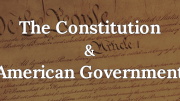By | LifeSiteNews (
Pro-lifers and honest pro-abortion legal scholars agree that Roe v. Wade was wrongly decided. But just how wrong is it? Is it bad law solely because it declares a right to something the Constitution is silent about, or does its judicial malpractice run deeper?
I have long argued that legal abortion violates not only the spirit of the Constitution, but the text itself – specifically, that the Fourteenth Amendment’s guaranteed equal protection of all people’s right to life has always applied to the preborn. Now, The Stream reports that the “Harvard Journal of Law and Public Policy” has published an article written by Harvard law student (and former Live Action contributor) Josh Craddock that lays out the case in perhaps the most depth it’s ever received.
The first key point of Craddock’s work, critiquing the late, great Justice Antonin Scalia from the right, is an audacious undertaking, but here it’s warranted. You see, while Scalia was a committed originalist and clear opponent of Roe, he was also of the opinion that the Constitution is neutral toward abortion – that its use of the word “persons” “clearly means walking-around persons,” and therefore, states should be left free to set whatever abortion laws they want. Craddock notes several other pro-life judicial originalists who hold (or held) this view, though Scalia is the most recent and most revered modernly.
Craddock concedes that there is some basis for this thinking because “natural rights were not exhaustively enshrined in the federal Constitution” and “states have traditionally decided the question of personhood.” However, he rightfully maintains that a truly originalist answer to the question has to consider what the word “persons” was understood to mean when the Fourteenth Amendment was written and ratified.
He proceeds to explain that layman’s dictionaries treated the concepts of humanity and personhood interchangeably, and so did legal terminology – more explicitly so, in fact. As we’ve discussed in the past, Craddock notes that Blackstone expressly recognized that personhood and the right to life existed before birth with a simple and clear legal standard: “where life can be shown to exist, legal personhood exists” (emphasis added). This also perfectly explains why it’s irrelevant that past laws didn’t protect the preborn prior to quickening.
Craddock next shows that many of the states that voted to ratify the Fourteenth Amendment had also criminalized abortion, meaning they understood personhood then in much the same way that pro-lifers understand it now:
By the time of the Fourteenth Amendment’s adoption, “nearly every state had criminal legislation proscribing abortion,” and most of these statutes were classified among “offenses against the person.” The original public meaning of the term “person” thus incontestably included prenatal life. Indeed, “there can be no doubt whatsoever that the word ‘person’ referred to the fetus.” In twenty‐three states and six territories, laws referred to the preborn individual as a “child.” Is it reasonable to presume that these legislatures would have used this terminology if “they had not considered the fetus to be a ‘person’”?
The adoption of strict anti‐abortion measures in the mid‐nineteenth century was the natural development of a long common‐law history proscribing abortion. Beginning in the mid‐thirteenth century, the common law codified abortion as homicide as soon as the child came to life (animation) and appeared recognizably human (formation), which occurred approximately 40 days after fertilization. Lord Coke later cited the “formed and animated standard,” rearticulating it as “quick with childe.”
From there, Craddock explains how the quickening standard was little more than a practical evidentiary standard, not a meaningful commentary on prenatal life (or lack thereof). But interestingly, he points out that even by the mid-nineteenth century, courts and states alike were increasingly rejecting it as scientifically obsolete, and replacing it with – surprise! – fertilization.
When the Amendment was adopted in 1868, the states widely recognized children in utero as persons. Twenty‐three states and six territories referred to the fetus as a “child” in their statutes proscribing abortion. At least twenty‐eight jurisdictions labeled abortion as an “offense[] against the person” or an equivalent criminal classification. Nine of the ratifying states explicitly valued the lives of the preborn and their pregnant mothers equally by providing the same range of punishment for killing either during the commission of an abortion. The “only plausible explanation” for this phenomenon is that “the legislatures considered the mother and child to be equal in their personhood.” Furthermore, ten states (nine of which had ratified the Fourteenth Amendment) considered abortion to be either manslaughter, assault with intent to murder, or murder.
Next, and perhaps most importantly, Craddock examines the thinking of the Fourteenth Amendment’s drafters. There’s an understandable assumption that because the amendment’s primary purpose was extending citizenship to freed blacks after the Civil War, its effects shouldn’t be construed to extend beyond that purpose. But under the originalist principle of authorial intent, the first word is often the last word in resolving such confusion:
Senator Jacob Howard, who sponsored the Amendment in the Senate, declared the Amendment’s purpose to “disable a state from depriving not merely a citizen of the United States, but any person, whoever he may be, of life, liberty and property without due process.” Even the lowest and “most despised of the [human] race” were guaranteed equal protection. Representative Thaddeus Stevens called the Amendment “a superstructure of perfect equality of every human being before the law; of impartial protection to everyone in whose breast God had placed an immortal soul” […] The primary Framer of the Fourteenth Amendment, Representative John Bingham, intended it to ensure that “no state in the Union should deny to any human being . . . the equal protection of the laws.”
In light of this evidence and reasoning (as well as rebuttals to possible objections I have skipped, but which you should take the time to read), Craddock concludes that there is only one proper constitutional approach to abortion:
If prenatal life is to be protected under the Fourteenth Amendment, Congress or the courts must intervene in states that do not guarantee equal protection and due process to preborn human beings. After all, “the [Fourteenth] amendment was designed to limit state power and authorize Congress to enforce such limitations.” Should a state refuse to protect prenatal life, it would be a violation of equal protection[.]
Exactly, and it’s not “statist” or “big government” or “judicial activism” to say so. The principle of limited government means the government mustn’t exceed its constitutional purposes, but protecting the right to life is its most basic purpose – and a national-level responsibility. While the Founding Fathers wanted federalism to leave states free to decide a wide range of policy decisions for themselves (so America’s large, diverse, spread out population could live in harmony under a single flag while expressing different secondary values and experimenting with different ideas), they also believed that a select few principles, like our most fundamental rights, require a uniform standard.
Craddock concludes on a pessimistic note, predicting that the Supreme Court is unlikely to abandon Roe anytime soon, making a human life amendment to the Constitution politically necessary even though it’s not legally necessary. That’s true for the time being…but it doesn’t have to be.
The past four decades’ worth of abortion jurisprudence has nothing to do with legal merit and almost everything to do with the partisan politics of the presidents who nominated judges and the senators who reviewed them. So while this rot has been allowed to fester for a long time, there are no legal barriers keeping us from challenging it – we need only the will and imagination to change our tactics.
We can demand that our presidents select bolder, more proven judges. We can push Congress to assert its coequal right and duty to protect individual rights by enacting the Life at Conception Act. And we can call on our lawmakers to exercise their constitutional powers to rein in and punish judges who refuse to protect the constitutional rights of every American.
This is where national-level pro-life activism needs to go…and fortunately, Josh Craddock has given that effort an unassailable foundation.





